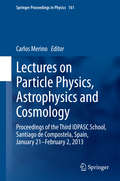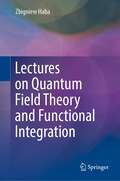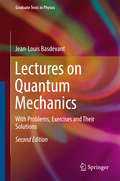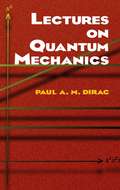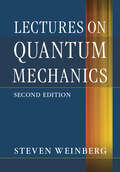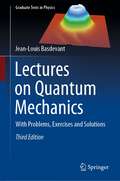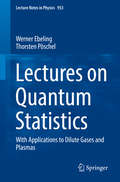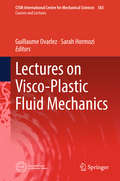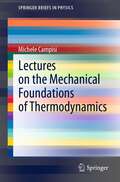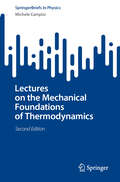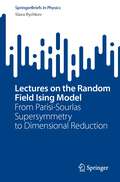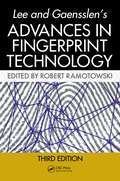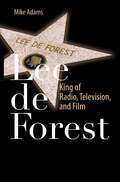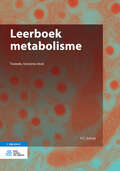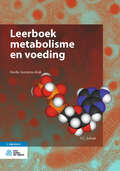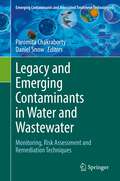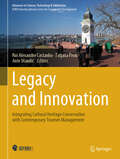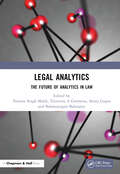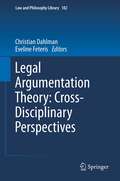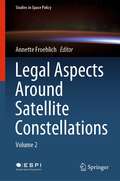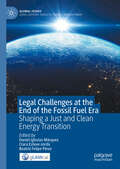- Table View
- List View
Lectures on Particle Physics, Astrophysics and Cosmology
by Carlos MerinoThis volume gathers the content of the courses held at the Third IDPASC School, which took place in San Martiño Pinario, Hospederia and Seminario Maior, in the city of Santiago de Compostela, Galiza, Spain, from January 21st to February 2nd, 2013. This school is the annual joint program of the International Doctorate Network in Particle Physics, Astrophysics, and Cosmology (IDPASC). The purpose of the school series is to present doctoral students from different universities and laboratories in Europe and beyond with a broad range of the latest results and current state of the art in the fields of Particle Physics, Astrophysics, and Cosmology, and to further introduce them to both the questions now posed by the potentials of physics and to challenges connected with current and future experiments - in particular, with the newly available energy ranges. Following these guidelines, the content of this third edition of the IDPASC School was jointly planned by the Academic Council and by the network's International Committee, whose members ensure every year its timely formulation, keeping up with the constant evolution of these fields. The program covers a balanced range of the latest developments in these fields worldwide, with courses offered by internationally acknowledged physicists on the Basic Features of Hadronic Processes, Quantum Chromodynamics, Physics and Technology of ALICE, LHCb Physics-Parity Violation, the Higgs System in and beyond the Standard Model, Higgs Searches at the LHC, Theory and Experiments with Cosmic Rays, Numerical Methods and Data Analysis in Particle Physics, Theoretical Cosmology, and AdS/CFT Correspondence. Most of these courses were complemented by practical and discussion sessions.
Lectures on Quantum Field Theory and Functional Integration
by Zbigniew HabaThis book offers a concise introduction to quantum field theory and functional integration for students of physics and mathematics. Its aim is to explain mathematical methods developed in the 1970s and 1980s and apply these methods to standard models of quantum field theory. In contrast to other textbooks on quantum field theory, this book treats functional integration as a rigorous mathematical tool. More emphasis is placed on the mathematical framework as opposed to applications to particle physics. It is stressed that the functional integral approach, unlike the operator framework, is suitable for numerical simulations. The book arose from the author's teaching in Wroclaw and preserves the form of his lectures. So some topics are treated as an introduction to the problem rather than a complete solution with all details. Some of the mathematical methods described in the book resulted from the author's own research.
Lectures on Quantum Mechanics
by Jean-Louis BasdevantBeautifully illustrated and engagingly written, Twelve Lectures in Quantum Mechanics presents theoretical physics with a breathtaking array of examples and anecdotes. Basdevant's style is clear and stimulating, in the manner of a brisk lecture that can be followed with ease and enjoyment. Here is a sample of the book's style, from the opening of Chapter 1: "If one were to ask a passer-by to quote a great formula of physics, chances are that the answer would be 'E = mc2'. . . . There is no way around it: all physics is quantum, from elementary particles, to stellar physics and the Big Bang, not to mention semiconductors and solar cells. "
Lectures on Quantum Mechanics
by Paul A. DiracThe author of this concise, brilliant series of lectures on mathematical methods in quantum mechanics was one of the shining intellects in the field, winning a Nobel prize in 1933 for his pioneering work in the quantum mechanics of the atom. Beyond that, he developed the transformation theory of quantum mechanics (which made it possible to calculate the statistical distribution of certain variables), was one of the major authors of the quantum theory of radiation, codiscovered the Fermi-Dirac statistics, and predicted the existence of the positron.The four lectures in this book were delivered at Yeshiva University, New York, in 1964. The first, "The Hamiltonian Method," is an introduction to visualizing quantum theory through the use of classical mechanics. The remaining lectures build on that idea. "The Problem of Quantization" shows how one can start with a classical field theory and end up with a quantum field theory. In "Quantization on Curved Surfaces," Dirac examines the possibility of building a relativistic quantum theory on curved surfaces. He deduces that it is not possible, but it should be possible on flat surfaces. In the final lecture, "Quantization on Flat Surfaces," he concludes that "we can set up the basic equations for a quantum theory of the Born-Infeld electrodynamics agreeing with special relativity, but [not] with general relativity." Physics and chemistry students will find this book an invaluable addition to their libraries, as will anyone intrigued by the far-reaching and influential ideas of quantum mechanics.
Lectures on Quantum Mechanics
by Steven WeinbergNobel Laureate Steven Weinberg combines his exceptional physical insight with his gift for clear exposition to provide a concise introduction to modern quantum mechanics. Ideally suited to a one-year graduate course, this textbook is also a useful reference for researchers. Readers are introduced to the subject through a review of the history of quantum mechanics and an account of classic solutions of the Schrödinger equation, before quantum mechanics is developed in a modern Hilbert space approach. The textbook covers many topics not often found in other books on the subject, including alternatives to the Copenhagen interpretation, Bloch waves and band structure, the Wigner-Eckart theorem, magic numbers, isospin symmetry, the Dirac theory of constrained canonical systems, general scattering theory, the optical theorem, the 'in-in' formalism, the Berry phase, Landau levels, entanglement and quantum computing. Problems are included at the ends of chapters, with solutions available for instructors at www. cambridge. org/9781107028722.
Lectures on Quantum Mechanics: With Problems, Exercises and Solutions (Graduate Texts in Physics)
by Jean-Louis BasdevantBeautifully illustrated and engagingly written, Twelve Lectures in Quantum Mechanics presents theoretical physics with a breathtaking array of examples and anecdotes. Basdevant’s style is clear and stimulating, in the manner of a brisk lecture that can be followed with ease and enjoyment. Here is a sample of the book’s style, from the opening of Chapter 1: "If one were to ask a passer-by to quote a great formula of physics, chances are that the answer would be ‘E = mc2’…. There is no way around it: all physics is quantum, from elementary particles, to stellar physics and the Big Bang, not to mention semiconductors and solar cells."
Lectures on Quantum Statistics: With Applications to Dilute Gases and Plasmas (Lecture Notes in Physics #953)
by Werner Ebeling Thorsten PöschelMost of the matter in our universe is in a gaseous or plasma state. Yet, most textbooks on quantum statistics focus on examples from and applications in condensed matter systems, due to the prevalence of solids and liquids in our day-to-day lives. In an attempt to remedy that oversight, this book consciously focuses on teaching the subject matter in the context of (dilute) gases and plasmas, while aiming primarily at graduate students and young researchers in the field of quantum gases and plasmas for some of the more advanced topics. The majority of the material is based on a two-semester course held jointly by the authors over many years, and has benefited from extensive feedback provided by countless students and co-workers. The book also includes many historical remarks on the roots of quantum statistics: firstly because students appreciate and are strongly motivated by looking back at the history of a given field of research, and secondly because the spirit permeating this book has been deeply influenced by meetings and discussions with several pioneers of quantum statistics over the past few decades.
Lectures on Visco-Plastic Fluid Mechanics (CISM International Centre for Mechanical Sciences #583)
by Guillaume Ovarlez Sarah HormoziThe book is designed for advanced graduate students as well as postdoctoral researchers across several disciplines (e.g., mathematics, physics and engineering), as it provides them with tools and techniques that are essential in performing research on the flow problems of visco-plastic fluids. The following topics are treated: analysis of classical visco-plastic fluid modelsmathematical modeling of flows of visco-plastic fluidscomputing flows of visco-plastic fluidsrheology of visco-plastic fluids and visco-plastic suspensionsapplication of visco-plastic fluids in engineering sciencescomplex flows of visco-plastic fluids.
Lectures on the Mechanical Foundations of Thermodynamics (SpringerBriefs in Physics)
by Michele CampisiThis brief provides a modern pedagogical exposition of the mechanical approach to statistical mechanics initiated by Boltzmann with his early works (1866-1871). Despite the later contribution by Helmholtz, Boltzmann himself (1884-1887), Gibbs, P. Hertz, and Einstein, the mechanical approach remained almost unknown to the modern reader, in favour of the celebrated combinatorial approach, developed by Boltzmann himself during his probabilistic turn (1876-1884). The brief constitutes an ideal continuation of a graduate course of classical mechanics and requires knowledge of basic calculus in many dimension (including differential forms), thermodynamics, probability theory, besides Hamiltonian mechanics. The cornerstone of the whole presentation is the ergodic hypothesis. Special attention is devoted to Massieu potentials (the Legendre transforms of the entropy) which are most natural in statistical mechanics, and also allow for a more direct treatment of the topic of ensemble equivalence.
Lectures on the Mechanical Foundations of Thermodynamics (SpringerBriefs in Physics)
by Michele CampisiThis book provides a modern pedagogical exposition of the mechanical approach to statistical mechanics initiated by Boltzmann with his early works (1866–1871). Despite the later contribution by Helmholtz, Boltzmann himself (1884–1887), Gibbs, P. Hertz, and Einstein, the mechanical approach remained almost unknown to the modern reader, in favour of the celebrated combinatorial approach, developed by Boltzmann himself during his probabilistic turn (1876–1884). The brief constitutes an ideal continuation of a graduate course of classical mechanics and requires knowledge of basic calculus in many dimensions (including differential forms), thermodynamics, and probability theory, besides Hamiltonian mechanics. The cornerstone of the whole presentation is the ergodic hypothesis. Special attention is devoted to Massieu potentials (the Legendre transforms of the entropy) which are most natural in statistical mechanics and also allow for a more direct treatment of the topic of ensemble equivalence. In this second edition, a chapter is added that addresses the long-debated question of how the second law of thermodynamics can be reconciled with mechanics, by using modern methods of non-equilibrium statistical mechanics.
Lectures on the Random Field Ising Model: From Parisi-Sourlas Supersymmetry to Dimensional Reduction (SpringerBriefs in Physics)
by Slava RychkovThis book is about the Random Field Ising Model (RFIM) – a paradigmatic spin model featuring a frozen disordering field. The focus is on the second-order phase transition between the paramagnetic and ferromagnetic phases, and the associated critical exponents. The book starts by summarizing the current knowledge about the RFIM from experiments, numerical simulations and rigorous mathematical results. It then reviews the classic theoretical works from the 1970’s which suggested a property of dimensional reduction – that the RFIM critical exponents should be the same as for the ordinary, non-disordered, Ising model of lower dimensionality, and related this an emergent Parisi-Sourlas supersymmetry. As is now known, these remarkable properties only hold when the spatial dimensionality of the model is larger than a critical dimension. The book presents a method to estimate the critical dimension, using standard tools such as the replica trick and perturbative renormalization group, whose result is in agreement with the numerical simulations. Some more elementary steps in the derivations are left as exercises for the readers. This book is of interest to researchers, PhD students and advanced master students specializing in statistical field theory.
Lectures on the Theory of Water Waves
by Thomas J Bridges Mark D. Groves David P. NichollsIn the summer of 2014 leading experts in the theory of water waves gathered at the Newton Institute for Mathematical Sciences in Cambridge for four weeks of research interaction. A cross-section of those experts was invited to give introductory-level talks on active topics. This book is a compilation of those talks and illustrates the diversity, intensity, and progress of current research in this area. The key themes that emerge are numerical methods for analysis, stability and simulation of water waves, transform methods, rigorous analysis of model equations, three-dimensionality of water waves, variational principles, shallow water hydrodynamics, the role of deterministic and random bottom topography, and modulation equations. This book is an ideal introduction for PhD students and researchers looking for a research project. It may also be used as a supplementary text for advanced courses in mathematics or fluid dynamics.
Lee and Gaensslen's Advances in Fingerprint Technology
by Allan GawReflecting new discoveries in fingerprint science, Lee and Gaensslen‘s Advances in Fingerprint Technology, Third Edition has been completely updated with new material and nearly double the references contained in the previous edition. The book begins with a detailed review of current, widely used development techniques, as well as some older, histo
Lee de Forest
by Mike AdamsThe life-long inventor, Lee de Forest invented the three-element vacuum tube used between 1906 and 1916 as a detector, amplifier, and oscillator of radio waves. Beginning in 1918 he began to develop a light valve, a device for writing and reading sound using light patterns. While he received many patents for his process, he was initially ignored by the film industry. In order to promote and demonstrate his process he made several hundred sound short films, he rented space for their showing; he sold the tickets and did the publicity to gain audiences for his invention. Lee de Forest officially brought sound to film in 1919. Lee De Forest: King of Radio, Television, and Film is about both invention and early film making; de Forest as the scientist and producer, director, and writer of the content. This book tells the story of de Forest's contribution in changing the history of film through the incorporation of sound. The text includes primary source historical material, U.S. patents and richly-illustrated photos of Lee de Forest's experiments. Readers will greatly benefit from an understanding of the transition from silent to audio motion pictures, the impact this had on the scientific community and the popular culture, as well as the economics of the entertainment industry.
Leerboek metabolisme
by Frans C. SchuitMetabolisme of stofwisseling gaat over chemische reacties die brandstoffen omzetten in nuttige energie en bouwstenen vanuit de voeding opbouwen tot bestanddelen van het lichaam. Dit complexe gebeuren heeft grote invloed op gezondheid en ziekte en vormt daarom een onmisbaar onderwerp in de opleidingen geneeskunde, mondzorg en biomedische wetenschappen. Aan de ene kant is het belangrijk om te weten hoe het metabolisme normaal werkt en inspeelt op dagelijkse veranderingen in de voedingstoestand en fysische activiteit. Aan de andere kant zijn er specifieke stofwisselingsziekten maar ook complexe bijdragen van een veranderd metabolisme aan frequente ziekten zoals diabetes en kanker. De 2e herziene druk van Leerboek metabolisme bestaat uit twaalf hoofdstukken, verdeeld over twee gedeelten. Het eerste gedeelte bevat de kernleerstof en wordt ondersteund door 270 afbeeldingen, concrete leerdoelen en studeeraanwijzingen. Het tweede gedeelte gaat nader in op bepaalde onderwerpen en tast hierbij grenzen van wetenschappelijk verantwoorde vakkennis af, bespreekt de rol van pioniers in vroeger onderzoek, benoemt het belang hiervan voor huidige medische toepassingen en beschouwt het onderwerp vanuit de evolutieleer. Deze verdieping in de stof is herkenbaar gemaakt in gekleurde kaders en wordt ruim ondersteund door verwijzingen naar recente literatuur. De veelzijdige samenstelling van de informatie biedt studenten de mogelijkheid een leerpad te volgen dat bij de eigen interesse aansluit. Door de opzet fungeert het boek als een gids tijdens een reis naar het onafhankelijk en kritisch kunnen nadenken over een complex onderwerp. De speciaal voor deze druk ontwikkelde website met toetsvragen biedt de daarbij horende gebruiksvriendelijke verdieping en ondersteuning.
Leerboek metabolisme en voeding
by F.C. SchuitDit boek behandelt de belangrijkste aspecten van het menselijke metabolisme op een inzichtelijke manier. Het bespreekt de basisbegrippen, de complexe relatie tussen metabolisme en voeding en tussen metabolisme en ziektemechanismen. Het boek is bestemd voor studenten geneeskunde, mondzorg, farmacie en biomedische wetenschappen, hbo voeding en diëtetiek. De inhoud van het boek is verweven met een van de pijlers van de bachelorfase van de hiervoor vermelde opleidingen: de chemische basis van gezondheid en ziekte. Metabolisme gaat over chemische reacties die brandstoffen omzetten in nuttige energie en bouwstenen vanuit de voeding opbouwen tot bestanddelen van het lichaam. Het is belangrijk om te weten hoe het metabolisme normaal werkt en inspeelt op dagelijkse veranderingen in de voedingstoestand en fysische activiteit. Maar ook wat er speelt bij specifieke stofwisselingsziekten en de complexe bijdragen van een veranderd metabolisme aan frequente ziekten zoals diabetes en kanker.De derde herziene druk van Leerboek metabolisme en voeding bestaat uit twaalf hoofdstukken. De kernleerstof wordt ondersteund door 270 afbeeldingen, concrete leerdoelen en studeeraanwijzingen. In elk hoofdstuk staan ook verdiepende kaders over de grenzen van wetenschappelijk verantwoorde vakkennis, de rol van pioniers in vroeger onderzoek, het belang hiervan voor huidige medische toepassingen en beschouwingen uit de evolutieleer. Daarbij wordt steeds verwezen naar recente literatuur.Op de bijbehorende website zijn 300 toetsvragen, casussen en hot topics te vinden.
Left Brain - Right Brain Differences: Inquiries, Evidence, and New Approaches
by James F. IaccinoThis volume integrates past clinical findings with the latest research on cerebral asymmetry in order to identify why humans process information in different ways. A must for anyone who wants to understand human cognitive nature further, specifically the reasons why we are "wired" a certain way and whether these cortical circuits are flexible enough to be altered, this book presents the most up-to-date information on hemispheric differences within normal and clinical populations. Its focus on sex, handedness, and developmental differences is critical to the derivation of a better perspective on how future research should be conducted in this expanding science. Iaccino begins by explaining basic brain structures and types of cognitive styles assigned to each hemisphere. He then details studies involving various clinical populations -- psychophysiological, split-brain, dyslexic, and psychotic -- to support the claim that the two hemispheres are different, morphologically and functionally speaking. Applying this clinical research to the more normal population, the author uncovers striking cortical variations between the sexes and between the handedness groups, along with developmental changes which occur as a function of time. Finally, he provides a detailed summary of the previous chapters and highlights where asymmetrical research may be headed in the future.
Left-Handedness and Brain Asymmetries: An Introduction (essentials)
by Sebastian OcklenburgThis Springer essential provides an overview of current research on the topic of left-handedness and brain asymmetries. In addition to basics of assessing left-handedness and brain asymmetries, it also explores their evolution, development, and their study in the animal kingdom. Other focal points include research on the relationship between left-handedness and cognitive functions, as well as the topic of handedness and sports. The essential is rounded off with a discussion on the topic of relearning handedness and a discourse on altered asymmetries in various patient groups.
Legacy and Emerging Contaminants in Water and Wastewater: Monitoring, Risk Assessment and Remediation Techniques (Emerging Contaminants and Associated Treatment Technologies)
by Daniel Snow Paromita ChakrabortyThis volume provides a collection of research findings on the distribution and risk associated with emerging contaminants (ECs) in water and wastewater across the globe, and effective remediation techniques and technologies. The book covers various monitoring techniques for ECs in water and wastewater and its related impacts on the ambient environment, and offers valuable information on cost-effective monitoring techniques and sustainable treatment technologies for ECs. The authors detail the risks and biological effects of ECs and legacy persistent organic pollutants (POPs) in freshwater and marine systems, including their adverse interactions with aquatic organisms, while also discussing the associated impacts on human health. The book comprehensively covers current research outcomes on treatment methods, cost-effectiveness, and infrastructure needs for effective removal of ECs. It will be of interest to students, researchers, and scholars in environmental science and engineering, water and wastewater, toxicology, environmental biotechnology, soil sciences, and microbial ecology.
Legacy and Innovation: Integrating Cultural Heritage Conservation with Contemporary Tourism Management (Advances in Science, Technology & Innovation)
by Ante Mandić Rui Alexandre Castanho Tatjana PivacThis book explores the intersection of culture, sustainability, and tourism. Also, it explores the importance of integrating cultural heritage preservation, environmental sustainability, and economic considerations in the development of tourism destinations. It provides a deep understanding of how cultural tourism can be harnessed to create positive and responsible tourism experiences that benefit local communities, protect natural resources, and promote cultural diversity. Drawing upon real-world examples and case studies, this book offers practical strategies and approaches for fostering sustainable tourism practices. It examines the role of technology in enhancing cultural tourism experiences, the impact of tourism on local economies, and the preservation of cultural vitality in peripheral areas. The book also analyzes the implications of the Covid-19 pandemic on the tourism industry and explores sustainable development models for the post-pandemic era. With a multidisciplinary approach, this book is a valuable resource for tourism professionals, policymakers, researchers, and students interested in the field of sustainable tourism. It emphasizes the need for a balanced and holistic approach that considers the social, environmental, and economic dimensions of cultural tourism. By promoting cultural understanding, environmental stewardship, and inclusive community engagement, "Cultural Sustainable Tourism" paves the way for a more sustainable and responsible future in the tourism industry. This book provides a diverse range of case studies and research insights into various aspects of sustainable tourism. It offers valuable perspectives on community-based approaches, cultural preservation, the impact of the Covid-19 pandemic, destination modeling, heritage restoration, and the interconnections between tourism, media, and culture. Throughout the book, readers will find a wealth of case studies, research insights, and practical examples from around the world. These real-world examples offer valuable lessons and best practices for implementing sustainable cultural tourism initiatives. The book also encourages critical thinking and reflection, inviting readers to consider the ethical dimensions of cultural tourism, the importance of local empowerment, and the long-term sustainability of tourism practices.
Legal Analytics: The Future of Analytics in Law
by Namita Singh Malik, Elizaveta A Gromova, Smita Gupta and Balamurugan BalusamyLegal Analytics: The Future of Analytics in Law navigates the crisscrossing of intelligent technology and legal field in building up new landscape of transformation. Legal automation navigation is multidimensional wherein it intends to construct streamline communication, approval and management of legal task. Evolving environment of technology has emphasized need for better automations in legal field from time to time. Although legal scholars took long to embrace Information revolution of legal field. •Describes the historical development of law and automation •Analyses the challenges and opportunities in law and automation •Studies the current research and development in the convergence of Law, Artificial Intelligence and Legal Analytics •Explores the recent emerging trends and technologies that are used by various legal System globally for Crime Prediction & Prevention •Examines the applicability of legal analytics in forensic investigation •Investigates the impact of legal analytics tools and techniques in judicial decision making •Analyses deep learning techniques and its scope in accelerating legal analytics in developed and developing countries • Provides the in-depth analysis of implementation, challenges and issues in the society related to legal analytics The book is primarily aimed at graduates, postgraduates in law & technology, computer science and information technology. Legal practitioners and academicians will also find this book helpful.
Legal Argumentation Theory: Cross-Disciplinary Perspectives
by Christian Dahlman Eveline FeterisThis book offers its readers an overview of recent developments in the theory of legal argumentation written by representatives from various disciplines, including argumentation theory, philosophy of law, logic and artificial intelligence. It presents an overview of contributions representative of different academic and legal cultures, and different continents and countries. The book contains contributions on strategic maneuvering, argumentum ad absurdum, argumentum ad hominem, consequentialist argumentation, weighing and balancing, the relation between legal argumentation and truth, the distinction between the context of discovery and context of justification, and the role of constitutive and regulative rules in legal argumentation. It is based on a selection of papers that were presented in the special workshop on Legal Argumentation organized at the 25th IVR World Congress for Philosophy of Law and Social Philosophy held 15-20 August 2011 in Frankfurt, Germany.
Legal Aspects Around Satellite Constellations: Volume 2 (Studies in Space Policy #31)
by Annette FroehlichThis book is the highly anticipated sequel to the previous volume under the same title, dedicated to presenting a diverse range of timely and valuable contributions on the legal and policy related questions evoked by satellite constellations, including emerging mega-constellations. Given the proliferation of activities in the field of satellite constellations, and the critical roles they play in supporting and enabling communication, navigation, disaster monitoring, Earth observation, security and scientific activities, the insights of legal and policy experts from around the world have been gathered in this second volume to help expand the scientific literature in this precious field. Topics range from legal obstacles and opportunities facilitating small satellite enterprise for emerging space actors, international cooperation in the compatibility and interoperability of navigation systems, the designation of satellite constellations as critical space infrastructure, to an analysis of the paradigm shift which has occurred over the last decade to make the proliferation of small satellite constellations possible, and more.
Legal Aspects of Implementing the Cartagena Protocol on Biosafety
by Marie-Claire Cordonier Segger Frederic Perron-Welch Christine FrisonThis book, the first in a new series that focuses on treaty implementation for sustainable development, examines key legal aspects of implementing the Cartagena Protocol on Biosafety to the UN Convention on Biological Diversity (CBD) at national and international levels. The volume provides a serious contribution to the current legal and political academic debates on biosafety by discussing key issues under the Cartagena Protocol on Biosafety that affect the further design of national and international law on biosafety, and analyzing recent progress in the development of domestic regulatory regimes for biosafety. It also examines the legal, political, economic, and practical challenges and solutions encountered in recent efforts to develop and implement domestic biosafety regulations, with a focus on developing countries. In the year of the fifth UN Meeting of the Parties to the Cartagena Protocol on Biosafety, at the signature of a new Nagoya-Kuala Lumpur Protocol on Liability and Redress, this timely book examines recent developments in biosafety law and policy.
Legal Challenges at the End of the Fossil Fuel Era: Shaping a Just and Clean Energy Transition (Global Issues)
by Daniel Iglesias Márquez Clara Esteve-Jordà Beatriz Felipe PérezThis edited collection proposes a wide range of approaches to address the legal issues pertaining to the end of the fossil fuel era. While the fossil fuel era is coming to an end both because of the inherent limits of its resources and because of the need to prevent to further pump out CO2 in an already saturated atmosphere, the legal dispositions to ensure an ordered and rational shift toward cleaner energy still need to be developed. Not only in relation to CO2 emissions themselves but also in relation to the manifold issues related to environmental justice in an era of global climate change and global warming. This book is unique in that it provides a theoretical framework but also works to address cutting edge issues through a series of case studies.
